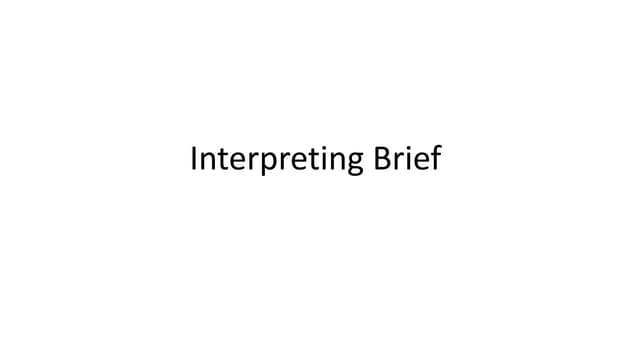Analyzing And Interpreting Briefs Effectively

Table of Contents
Deconstructing the Brief: Understanding the Client's Needs
Understanding the client's needs is the cornerstone of effective brief analysis. This involves more than just a cursory reading; it requires a deep dive into the document to extract every piece of relevant information. Successfully interpreting a client brief relies on identifying the core problem, objectives, and desired outcomes. Key components to analyze include:
-
Identifying the Core Problem: What is the fundamental issue the client is trying to solve? Is it declining sales, a lack of brand awareness, poor customer engagement, or something else? Clearly defining the problem sets the stage for the entire project. Poorly defined problems often lead to irrelevant solutions.
-
Pinpointing Objectives and Desired Outcomes: What specific, measurable, achievable, relevant, and time-bound (SMART) goals does the client have? These objectives should be clearly articulated in the brief, often expressed as KPIs (Key Performance Indicators). Understanding these KPIs is vital for measuring project success. For example, a marketing brief might aim for a 20% increase in website traffic within three months.
-
Analyzing the Target Audience: Who is the client trying to reach? Understanding the target audience's demographics, psychographics, behaviors, and needs is paramount. This information informs all aspects of the project, from messaging and design to channel selection. A detailed understanding of the target audience ensures that all efforts are appropriately focused.
-
Understanding Budget and Timeline Constraints: Every project operates within budget and time constraints. Carefully reviewing these limitations early in the process prevents unrealistic expectations and allows for efficient resource allocation. A clear understanding of the budget will influence the scope of the project and the chosen strategies.
-
Examining Deliverables and KPIs: What tangible outputs are expected? This could include a website, a marketing campaign, a design mockup, a software application, or a report. Clearly defining the deliverables ensures that everyone is on the same page about the project's scope. Understanding the defined KPIs helps ensure you measure success accurately.
Identifying Key Information and Potential Challenges
Even with a seemingly clear brief, potential challenges and ambiguities can arise. Proactive identification of these issues is critical for project success. This stage involves a thorough review for inconsistencies, unclear instructions, and potential risks.
-
Highlighting Conflicting Information or Unclear Instructions: Are there any contradictions within the brief itself? Do some sections conflict with others? Are the instructions vague or open to multiple interpretations? These ambiguities need to be clarified early on to prevent misunderstandings and rework.
-
Identifying Potential Risks: What potential challenges could hinder the project's success? This could include technical difficulties, resource limitations, or external factors. Identifying and proactively addressing these risks is crucial for mitigating potential problems.
-
Developing Strategies for Clarifying Ambiguities: Don't hesitate to ask clarifying questions. Schedule a meeting with the client to discuss any uncertainties. Document all communications to maintain a clear record of the discussions and agreements reached.
-
Proactive Communication: Regularly communicate potential challenges and solutions to the client. This transparency builds trust and ensures everyone is aligned on the project's path forward. Proactive communication is key to managing expectations.
-
Documenting Assumptions and Clarifications: Maintain a detailed record of all assumptions made and clarifications received. This documentation is invaluable for resolving disputes and ensuring accountability throughout the project lifecycle. A well-maintained log of communications will prove vital.
Developing a Comprehensive Action Plan Based on the Brief Analysis
Once you've thoroughly analyzed the brief and identified potential challenges, it's time to develop a comprehensive action plan. This plan should translate the brief's requirements into actionable steps.
-
Breaking Down the Project into Manageable Tasks: Divide the project into smaller, more manageable tasks. This makes the project less daunting and allows for better tracking of progress. Use project management tools to efficiently manage tasks.
-
Creating a Realistic Timeline and Allocating Resources: Develop a realistic timeline for completing each task, taking into account potential delays. Allocate the necessary resources—personnel, budget, and tools—to each task.
-
Developing a Communication Plan: Establish a clear communication plan for regular updates with the client. This ensures transparency and allows for timely feedback. Regular communication keeps everyone informed.
-
Establishing a Progress Tracking System: Implement a system for tracking progress and addressing any deviations from the plan. This ensures that the project stays on track and that potential problems are identified and addressed promptly. Regular progress reports will highlight any issues.
-
Defining Success Criteria: Define success criteria based on the client's KPIs. This ensures that the project's success can be objectively measured. Clear metrics are necessary to evaluate performance.
Utilizing Different Brief Types Effectively
Different project types utilize different brief structures. Understanding the nuances of each is crucial for effective analysis.
-
Marketing Briefs: These focus on marketing objectives, target audiences, and campaign strategies. They require a strong understanding of marketing principles and analytics.
-
Design Briefs: These emphasize visual communication, branding, and user experience. A strong grasp of design principles is necessary to properly analyze design briefs.
-
Creative Briefs: These focus on inspiring creative solutions and often involve less structured guidelines. They demand flexibility and innovative thinking.
-
Technical Briefs: These are highly detailed and focus on technical specifications and requirements. A deep understanding of technical details is necessary.
Conclusion
Mastering the art of analyzing and interpreting briefs is paramount for project success. By systematically deconstructing the brief, identifying potential challenges, and developing a comprehensive action plan, you can ensure that your project aligns perfectly with the client's needs and objectives. Learn to effectively analyze and interpret briefs to elevate your project management skills and deliver exceptional results. Improve your brief analysis techniques today and transform your project outcomes!

Featured Posts
-
 Swiss Village Cow Evacuation Airlift Completes 96 Animal Rescue
May 23, 2025
Swiss Village Cow Evacuation Airlift Completes 96 Animal Rescue
May 23, 2025 -
 The Thorn In Mc Larens Side Understanding Hamiltons Recent Admission
May 23, 2025
The Thorn In Mc Larens Side Understanding Hamiltons Recent Admission
May 23, 2025 -
 The Whos Drummer Change Zak Starkey Returns
May 23, 2025
The Whos Drummer Change Zak Starkey Returns
May 23, 2025 -
 Kosova Dhe Uefa Perfitimet Nga Ngritja Ne Ligen B Te Liges Se Kombeve
May 23, 2025
Kosova Dhe Uefa Perfitimet Nga Ngritja Ne Ligen B Te Liges Se Kombeve
May 23, 2025 -
 James Wiltshires 10 Years At The Border Mail A Retrospective
May 23, 2025
James Wiltshires 10 Years At The Border Mail A Retrospective
May 23, 2025
Latest Posts
-
 Brundle Exposes Unexpected Aspects Of Lewis Hamiltons Life
May 23, 2025
Brundle Exposes Unexpected Aspects Of Lewis Hamiltons Life
May 23, 2025 -
 Controversial Findings Brundles Report On Lewis Hamilton
May 23, 2025
Controversial Findings Brundles Report On Lewis Hamilton
May 23, 2025 -
 Brundles Revelation Unsettling Truths About Lewis Hamilton
May 23, 2025
Brundles Revelation Unsettling Truths About Lewis Hamilton
May 23, 2025 -
 Bishop Englands Dance Legacy Continues Two Graduates Join Louisville For 2025 Ncaa Tournament
May 23, 2025
Bishop Englands Dance Legacy Continues Two Graduates Join Louisville For 2025 Ncaa Tournament
May 23, 2025 -
 Urgent Livestock Evacuation In Switzerland Landslide Danger Prompts Helicopter And Ground Response
May 23, 2025
Urgent Livestock Evacuation In Switzerland Landslide Danger Prompts Helicopter And Ground Response
May 23, 2025
